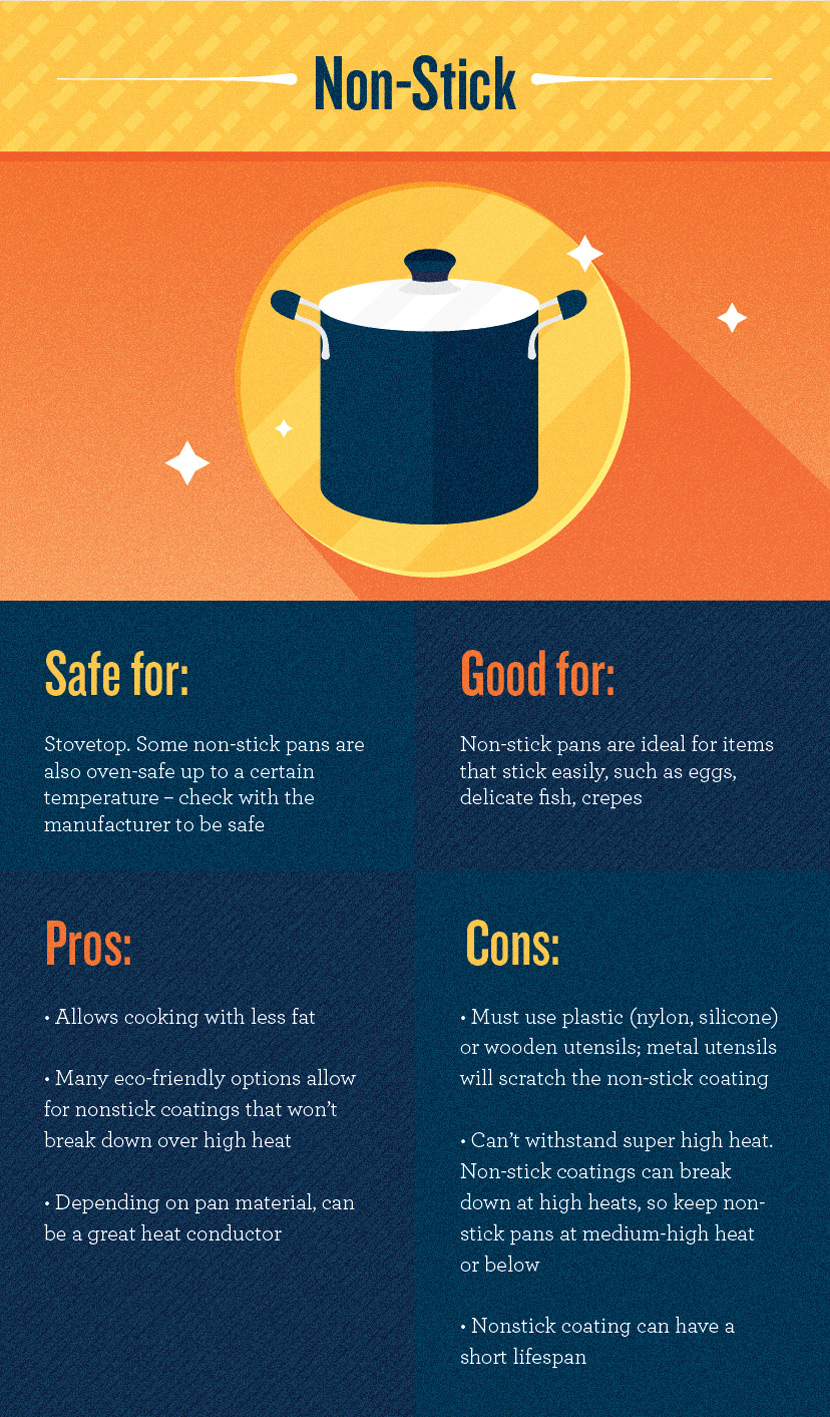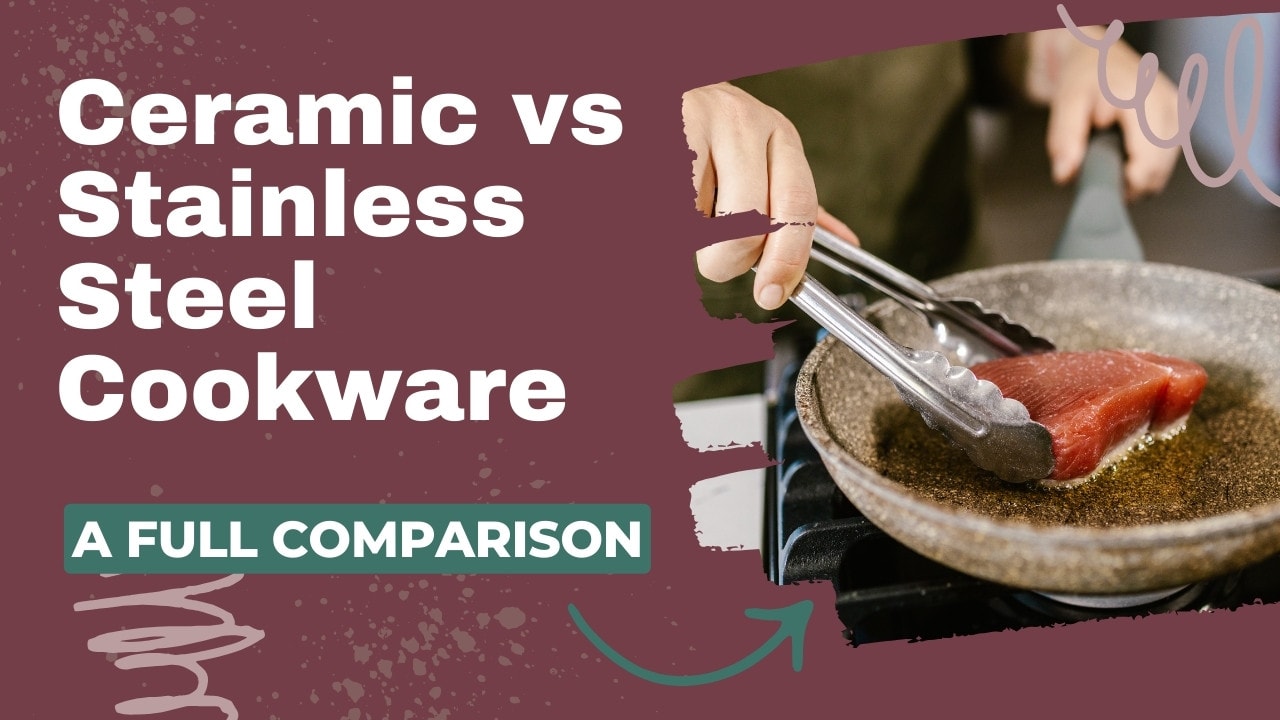As an Amazon Associate, I earn from qualifying purchases
Ceramic cookware is better than nonstick cookware because it is more durable and chemical-free. With its ability to withstand high temperatures and even heat distribution, ceramic cookware offers a safer and healthier cooking experience.
Additionally, its non-reactive nature prevents any unwanted flavors from transferring to the food, ensuring a more authentic taste. The smooth surface of ceramic cookware also makes it easier to clean and requires less oil during cooking, promoting a healthier lifestyle.
Furthermore, ceramic cookware is scratch-resistant and can withstand the use of metal utensils, making it suitable for long-term use. Overall, ceramic cookware surpasses nonstick cookware in terms of durability, health benefits, and versatility.
Table of Contents
ToggleMaterial Composition
When evaluating cookware options between ceramic and non-stick, consider the material composition. Ceramic cookware is eco-friendly, non-toxic, and durable, ideal for even heat distribution. Non-stick cookware offers easy food release and simple cleanup but may deteriorate over time.
Ceramic cookware is made from natural minerals and clay baked at high temperatures. Non-stick cookware, on the other hand, has a synthetic coating that prevents food from sticking.Ceramic Cookware Composition
– Made from natural minerals and clay. – Baked at high temperatures to form a durable surface. – Environmentally friendly and non-toxic cooking option.Non-stick Cookware Composition
– Typically constructed with a synthetic coating. – Designed to prevent food from sticking to the surface. – Requires careful handling to avoid damage to the coating.
Credit: www.fix.com
Durability
When it comes to choosing cookware, durability is a top consideration. You want a kitchen companion that can withstand the wear and tear of daily use, giving you long-lasting performance and value for your money. In this article, we’ll explore the durability of both ceramic and non-stick cookware options, so you can make an informed decision.
Longevity Of Ceramic Cookware
Ceramic cookware is known for its toughness and resilience. Made from a hard material like clay or porcelain, ceramic pots and pans are designed to withstand high temperatures and resist scratching or chipping. This makes them highly durable and long-lasting, ensuring they can serve you well in your kitchen for years to come.
Furthermore, ceramic cookware is typically oven-safe, allowing you to use it not only on stovetops but also for baking or broiling in the oven. This versatility enhances its durability and gives you the freedom to explore different cooking techniques without worrying about damaging your cookware.
In addition to its durability, ceramic cookware is also non-reactive, meaning it won’t interact with your food and affect its taste or nutritional value. This makes it a safe and healthy choice for your everyday cooking needs.
Longevity Of Non-stick Cookware
Non-stick cookware, on the other hand, is known for its convenience and ease of use. The non-stick coating applied to the surface of the cookware prevents food from sticking, making it effortless to cook and clean. However, when it comes to durability, non-stick cookware may have some limitations.
The non-stick coating on these pans can wear off over time, especially if not properly cared for or used with metal utensils. This can lead to decreased performance and the need for replacement. However, advancements in non-stick technology have resulted in more durable options that are designed to resist scratching and maintain their non-stick properties for longer.
If you opt for non-stick cookware, it is crucial to follow the manufacturer’s instructions for proper care and use. Avoid using metal utensils, harsh scrubbing tools, or high heat settings, as these can damage the non-stick coating and reduce its longevity. With proper care, non-stick cookware can still provide you with several years of reliable use.
Cooking Performance
When choosing between ceramic and non-stick cookware, it’s essential to consider their cooking performance. Each type of cookware has its unique features that directly impact the cooking experience.
Heat Distribution In Ceramic Cookware
Ceramic cookware is acclaimed for its excellent heat distribution. Due to its solid construction and even heat retention, ceramic pots and pans ensure uniform cooking results. The material’s ability to retain heat effectively allows for consistent and reliable cooking.
Heat Distribution In Non-stick Cookware
Non-stick cookware, on the other hand, offers quick and even heat distribution. The non-stick coating minimizes the risk of hot spots, promoting uniform cooking throughout the surface of the cookware. This feature is particularly beneficial for recipes that require precise temperature control.

Credit: theskillfulcook.com
Health And Safety
When it comes to choosing the right cookware for your kitchen, health and safety are paramount considerations. Understanding the potential health benefits of ceramic cookware and the safety concerns of non-stick cookware can help you make an informed decision for your cooking needs.
Potential Health Benefits Of Ceramic Cookware
Ceramic cookware is known for being a healthy option due to its non-toxic nature. Free from harmful chemicals such as PFOA and PTFE, ceramic cookware ensures that no toxic fumes or particles are released into your food, keeping it safe for consumption.
Furthermore, ceramic cookware is excellent for low-fat cooking as it requires less oil, which can lead to healthier meals. It also retains heat well, allowing for even cooking without the need for excessive heat or prolonged cooking times, thus preserving nutrients in the food.
Safety Concerns Of Non-stick Cookware
Non-stick cookware, on the other hand, raises concerns about the potential health risks associated with the chemicals used in the non-stick coating. Overheating non-stick pans can lead to the release of toxic fumes, posing a risk to both the chef and the food being prepared.
In addition, the abrasion of the coating over time could lead to the ingestion of harmful particles, impacting health. Regular replacement of non-stick cookware is often recommended to mitigate this risk.
Maintenance And Cleaning
Maintaining and cleaning your cookware is an essential part of keeping it in top condition and ensuring it lasts for years. When it comes to ceramic and non-stick cookware, understanding the proper cleaning methods can make a big difference in their longevity and performance. In this section, we will discuss how to clean ceramic cookware and non-stick cookware.
Cleaning Ceramic Cookware
Ceramic cookware is known for its durability and non-toxic properties, making it a popular choice among health-conscious home cooks. When it comes to cleaning ceramic cookware, here are some tips to keep in mind:
- Hand washing is recommended to preserve the ceramic coating. Avoid using abrasive scrubbers or harsh detergents as they can damage the surface.
- Soak the cookware in warm, soapy water to loosen any stuck-on food particles before washing.
- Use a non-abrasive sponge or cloth to gently clean the surface. Avoid using metal utensils or sharp objects that can scratch the ceramic coating.
- For stubborn stains or burnt-on food, create a paste using baking soda and water. Apply this paste to the affected areas and let it sit for a few minutes before gently scrubbing.
- Rinse the cookware thoroughly with warm water to remove any soap residue. Dry it completely before storing.
By following these simple cleaning steps, you can maintain the shine and functionality of your ceramic cookware for years to come.
Cleaning Non-stick Cookware
Non-stick cookware is favored for its effortless food release and easy cleanup. To keep your non-stick cookware in great shape, follow these cleaning tips:
- Allow the cookware to cool down before washing it. Placing hot non-stick pans under cold water can cause warping or damage to the coating.
- Use a non-abrasive sponge or soft cloth to gently clean the surface. Avoid using metal scrubbers or sharp utensils that can scratch the non-stick coating.
- For stubborn residues or stains, fill the cookware with warm, soapy water and let it soak for a while. This will loosen the stuck-on food, making it easier to clean.
- Gently scrub the surface with a sponge or cloth. If needed, you can use a mild dish soap or baking soda paste to help remove any tough stains.
- Rinse the cookware thoroughly to ensure there is no soap residue left behind. Dry it completely before storing.
Following these cleaning techniques will help prolong the life of your non-stick cookware and maintain its non-stick properties.
Environmental Impact
When considering cookware options, it’s essential to assess their environmental impact. Both ceramic and non-stick cookware can have varying effects on the environment.
Sustainability Of Ceramic Cookware
- Ceramic cookware is made from natural materials like clay and sand, promoting sustainability.
- Production of ceramic cookware involves minimal processing, reducing environmental pollution.
- These eco-friendly qualities make ceramic cookware a sustainable choice for environmentally conscious consumers.
Environmental Impact Of Non-stick Cookware
- Non-stick cookware is often coated with synthetic chemicals like PTFE and PFOA, posing environmental risks.
- These chemicals can release harmful toxins when heated, contributing to air and water pollution.
- Disposal of non-stick cookware can also lead to environmental contamination due to the presence of these chemicals.
| Cookware Type | Environmental Impact |
|---|---|
| Ceramic | Promotes sustainability with natural materials and minimal processing. |
| Non-Stick | Uses synthetic chemicals that can contribute to pollution during production and disposal. |

Credit: www.nytimes.com
Frequently Asked Questions On Which Is Better Ceramic Or Non Stick Cookware
Is Ceramic Cookware Better Than Non-stick Cookware?
Ceramic cookware offers a natural non-stick surface and is free from harmful chemicals like PFOA. It’s also more resistant to high temperatures and scratches than traditional non-stick cookware.
What Are The Advantages Of Using Non-stick Cookware?
Non-stick cookware allows for easy food release, requiring less oil for cooking and making cleanup a breeze. It’s ideal for delicate foods like eggs and fish and is generally affordable and easy to maintain.
Can Non-stick Cookware Be Harmful To Health?
Low-quality non-stick cookware may release harmful chemicals when overheated. However, high-quality non-stick cookware, free from PFOA and other toxic substances, is considered safe for regular cooking use. Always follow the manufacturer’s guidelines for safe usage.
How Do I Choose Between Ceramic And Non-stick Cookware?
Consider your cooking preferences and lifestyle. Ceramic cookware is more environmentally friendly and non-toxic, while non-stick cookware is convenient for low-fat cooking and easy cleaning. Both have their benefits, so choose based on your priorities.
Conclusion
Both ceramic and non-stick cookware have their own advantages and considerations. Ceramic cookware is known for its durability, non-toxic nature, and even heat distribution. On the other hand, non-stick cookware offers effortless food release and easy cleaning. Ultimately, the choice between them depends on personal preferences, cooking style, and budget.
So, consider your needs and make an informed decision. Happy cooking!
As an Amazon Associate, I earn from qualifying purchases
